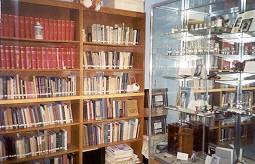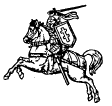
LITHUANIAN MUSEUM OF MEDICINE AND ARCHIVES
The museum was founded in 1988 at the Lithuanian Research and Studies Center
on the initiative of Dr. Milda Budrys and Prof. Jonas Rackauskas, and is currently
the only museum of its kind outside of Lithuania, tracing the lives and careers of
physicians from Lithuania to the Displaced Person (DP) camps in Germany to their
immigration and life in the United States. Since 1950, the museum’s founder and
then-director Dr. Milda Budrys has been collecting artifacts and other documentary
materials on Lithuanian physicians. In 1956,
the son of noted Lithuanian pharmacist
Pranas Rakas, F. Rakas, donated his
father’s collection to the museum, including
some antique medical equipment that had
been stored at his pharmacy. Also
exhibited are various instruments and
personal items associated with noted
Lithuanian physicians, pharmaceuticals
of Lithuanian manufacture, antique dental
equipment, the Red Cross flag of former
radio personality Sophie Barcus, personal
items of former Lithuanian president Dr. Kazys Grinius, even the keys and seal of
the Vytautas Magnus University Medical Faculty.
The museum’s library houses books written by Lithuanian émigré physicians and
current Lithuanian medical literature generously provided on a regular basis by
Lithuanian physicians and scientists. The M. Mazvydas National Library of Lithuania
also provides the museum’s library with scientific and medical literature.
Due to the generosity of friends and supporters of the museum the collection is ever-
expanding with gifts of medical equipment, documents, photographs, instruments,
books, antique medical supplies.
The museum also has an archive of historical documents pertaining to Lithuanian
physicians: diplomas, correspondence, awards, manuscripts, etc. Of note are the
collections of Dr. Motiejus Nasvytis, an epidemiologist in the pre WWII Lithuanian
Army, and that of Dr. A. L. Graiciunas, which contains materials and documents over
100 years old.
As its collections grew, the museum expanded into the second corridor of the
Lithuanian Museum and now includes a portrait gallery, an antique field surgeon’s
instruments kit, and a vast collection of ornate pillboxes.
The Lithuanian Research and Studies Center has an agreement of cooperation with
the Central Medical Library of Lithuania, which supplies the museum’s library with
current medical periodicals. In return, the Lithuanian Research and Studies Center
sends the Library with the most current medical literature, which is provided by the
American Lithuanian Medical Association.
TOP OF PAGE
The museum was founded in 1988 at the Lithuanian Research and Studies Center
on the initiative of Dr. Milda Budrys and Prof. Jonas Rackauskas, and is currently
the only museum of its kind outside of Lithuania, tracing the lives and careers of
physicians from Lithuania to the Displaced Person (DP) camps in Germany to their
immigration and life in the United States. Since 1950, the museum’s founder and
then-director Dr. Milda Budrys has been collecting artifacts and other documentary
materials on Lithuanian physicians. In 1956,
the son of noted Lithuanian pharmacist
Pranas Rakas, F. Rakas, donated his
father’s collection to the museum, including
some antique medical equipment that had
been stored at his pharmacy. Also
exhibited are various instruments and
personal items associated with noted
Lithuanian physicians, pharmaceuticals
of Lithuanian manufacture, antique dental
equipment, the Red Cross flag of former
radio personality Sophie Barcus, personal
items of former Lithuanian president Dr. Kazys Grinius, even the keys and seal of
the Vytautas Magnus University Medical Faculty.
The museum’s library houses books written by Lithuanian émigré physicians and
current Lithuanian medical literature generously provided on a regular basis by
Lithuanian physicians and scientists. The M. Mazvydas National Library of Lithuania
also provides the museum’s library with scientific and medical literature.
Due to the generosity of friends and supporters of the museum the collection is ever-
expanding with gifts of medical equipment, documents, photographs, instruments,
books, antique medical supplies.
The museum also has an archive of historical documents pertaining to Lithuanian
physicians: diplomas, correspondence, awards, manuscripts, etc. Of note are the
collections of Dr. Motiejus Nasvytis, an epidemiologist in the pre WWII Lithuanian
Army, and that of Dr. A. L. Graiciunas, which contains materials and documents over
100 years old.
As its collections grew, the museum expanded into the second corridor of the
Lithuanian Museum and now includes a portrait gallery, an antique field surgeon’s
instruments kit, and a vast collection of ornate pillboxes.
The Lithuanian Research and Studies Center has an agreement of cooperation with
the Central Medical Library of Lithuania, which supplies the museum’s library with
current medical periodicals. In return, the Lithuanian Research and Studies Center
sends the Library with the most current medical literature, which is provided by the
American Lithuanian Medical Association.
TOP OF PAGE













